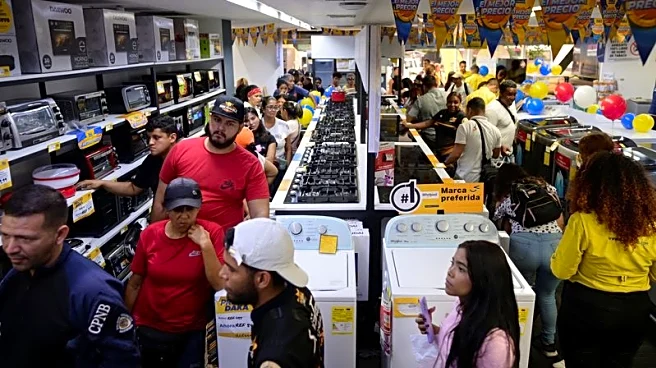What's Happening?
Black Friday, historically known for chaotic shopping scenes, has seen a significant shift towards online shopping. The term originated in the 1950s in Philadelphia due to the overwhelming crowds and traffic
jams. By the 1980s, retailers transformed Black Friday into a positive event, marking the start of the holiday shopping season with significant discounts. However, the rise of e-commerce giants like Amazon has moved much of the shopping online, reducing the stress and chaos associated with physical stores. Online shopping has become the dominant mode, surpassing Cyber Monday in terms of online purchases. Despite the shift, Black Friday still generates billions in consumer spending, with online sales reaching $9.12 billion in 2022.
Why It's Important?
The shift to online shopping for Black Friday has significant implications for retailers and consumers. It reduces the risks associated with large crowds, such as violence and injuries, which have historically been a concern. Retailers benefit from extended sales periods, spreading out consumer spending and reducing the pressure on physical stores. This transformation also allows for better management of store capacity and security measures, enhancing safety. For consumers, the convenience of online shopping and extended sales periods offers more opportunities to find deals without the stress of in-store shopping. The change reflects broader trends in retail, where digital platforms increasingly dominate.
What's Next?
Retailers are likely to continue expanding Black Friday sales into longer promotional periods, effectively creating 'Black November.' This approach helps manage consumer demand and reduces the risks associated with single-day events. As online shopping continues to grow, retailers may invest more in cybersecurity to protect consumer data during peak shopping times. Additionally, the focus on online sales may lead to further innovations in digital marketing and customer engagement strategies. Physical stores may adapt by enhancing in-store experiences to complement online offerings, ensuring they remain competitive in the evolving retail landscape.
Beyond the Headlines
The shift from traditional Black Friday shopping to online platforms raises questions about the future of physical retail spaces. As consumers increasingly prefer online shopping, brick-and-mortar stores may need to reinvent themselves to attract foot traffic. This could involve creating unique in-store experiences or integrating technology to enhance shopping convenience. The trend also highlights the growing importance of cybersecurity, as retailers must protect against data breaches during high-traffic shopping events. Furthermore, the environmental impact of increased online shopping, such as packaging waste and delivery emissions, may become a more prominent concern.














